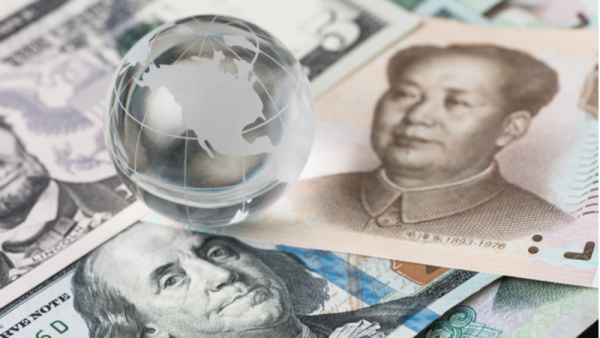eamesBot / Shutterstock

James Laurenceson, Director, Australia-China Relations Institute, University of Technology Sydney |
This article appeared in Pearls and Irritations, a public affairs blog, on December 1 2021.
Almost as soon as Beijing launched a campaign of trade punishment against Australia in May 2020, the instinct of many in Canberra was to reach for support from the US, our 'great and powerful friend'.
For some, it was a moment of pride in July 2020 when Donald Trump’s secretary of state, Mike Pompeo, commended the Morrison government for 'standing up for democratic values and the rule of law despite intense, continued, coercive pressure from the Chinese Communist Party'.
Their excitement built when The Wall Street Journal reported in late November that 'senior Trump administration officials' were pushing for an 'ambitious effort [that] would create an informal alliance of Western nations to jointly retaliate when China uses its trading power to coerce countries'. These officials were, of course, on their way out of office by then.
But the incoming Biden administration was emphasising that working closely with allies was a foreign policy priority. During the transition period, Biden’s national security adviser, Jake Sullivan, laid down an early marker by emphasising that the US stood 'shoulder to shoulder' with Australia.
But what brought a rapturous local response was a post-inauguration message delivered in March 2021 by Kurt Campbell, Biden’s 'Indo-Pacific czar'. In an exclusive interview with Sydney Morning Herald columnist Peter Hartcher, Campbell insisted the US was 'not prepared to improve relations' with China while its 'close and dear ally' was being hit with economic coercion. The US was 'not going to leave Australia alone on the field'. 'It’s just not going to happen,' Campbell assured.
The same month, the chargé d’affaires at the US embassy here, Mike Goldman, reinforced the message, telling local media the US would 'absolutely have Australia’s back'. In May, Secretary of State Antony Blinken added a cricketing twist to Campbell’s earlier assurance, insisting the US would 'not leave Australia alone on the pitch'.
As 2021 draws to a close, Australians are now in a position to compare rhetoric with reality. And as a new report by the Australia-China Relations Institute at the University of Technology Sydney (UTS:ACRI) shows, economic reality bites.
For starters, even the Biden administration’s rhetoric has shifted. While China’s trade punishment of Australia has not relented, in September US Commerce Secretary Gina Raimondo was not exactly signalling solidarity: 'There’s no point talking about decoupling… we have no interest in a cold war with China. It’s too big of an economy – we want access to their economy, they want access to our economy'.
A few days later, US Trade Representative Katherine Tai said her goal was 'a kind of recoupling'. She planned to tackle ongoing US concerns through direct dialogue and negotiations with her Chinese counterparts. Meanwhile, Australia’s Trade Minister, Dan Tehan, has not been able to secure a phone call with his opposite number in Beijing since he took on the portfolio a year ago.
Then there’s the cold, hard facts revealed by trade data. In January-September 2021, China’s imports from Australia of 12 disrupted goods fell by US$12.6 billion compared with 2019. The country gaining the most at Australia’s expense was the US. Its sales of the same goods to China leapt by US$4.6 billion. Two of Australia’s other strategic friends were among the top five beneficiaries: sales to China from Canada and New Zealand rose by US$1.1 billion and US$786 million respectively.
After Beijing imposed prohibitive tariffs last November, prominent voices in the capitals of strategic allies urged their compatriots to step up their purchases of Australian 'freedom' and 'democracy' wine. Alas, while Australian wine sales to China are down by a gigantic US$481 million, increased US purchases compensated to the tune of just US$7.1 million. For Australia’s wine makers, diversification remains as difficult, long and costly a process as ever.
It’s not only wine makers that are finding market diversification a lot harder than some commentators pretend. A new survey by Austrade, the Export Council of Australia and the University of Canberra reports that when it comes to South Korea, Japan, Vietnam and Taiwan, among others, the 'percentage of businesses interested in this market reporting diversification challenges' is even greater than for China.
To be sure, when it comes to Australian commodity producers the pain has largely been mitigated by global markets swiftly redirecting their sales elsewhere at low cost. But with the UTS:ACRI report showing more coal now going to Turkey (up US$191 million), barley to Saudi Arabia (up US$520 million) and cotton to Vietnam (up US$351 million), it’s clear that shared values haven’t suddenly replaced China as a driver of Australia’s prosperity.
None of these economic realities excuse or deflect attention away from Beijing’s actions being the source of Australia’s trade predicament. Nor are they to argue that Canberra should not seek support from like-minded partners and stand up for Australian values. Even support that is limited to rhetoric raises reputational costs to Beijing internationally.
But the general public should not be under any illusion about the costs involved and who will bear them – Australia and Australia alone. And with no other country experiencing the breadth of trade disruption that Australia is, it is legitimate to ask whether these costs were avoidable if the Morrison government had practised more adroit diplomacy.
Related works
- James Laurenceson and Thomas Pantle, ‘Economic reality bites: What Australia needs to know amidst US-China strategic competition’, Australia-China Relations Institute, University of Technology Sydney, November 30 2021
Author
Professor James Laurenceson is Director of the Australia-China Relations Institute at the University of Technology Sydney.


